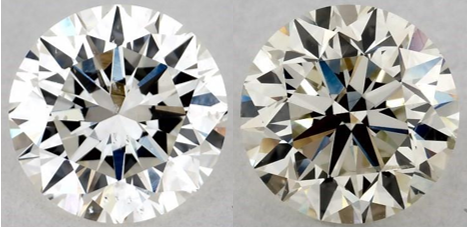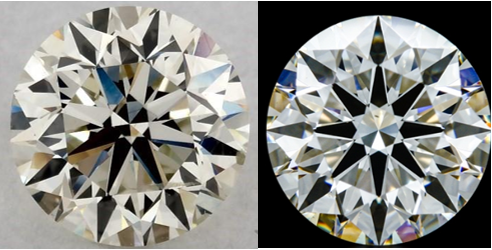This page contains references to diamonds or engagement rings from different companies. Sometimes I do receive a commission when you click on links and buy the products.
The popularity of online vendors and the wealth of diamond knowledge that they provide has caused the diamond market to shift. Gone are the days then a suited and booted salesperson could use artistic license and questionable information to close a sale; the modern diamond buyer is informed and armed with industry specific knowledge. They want a beautiful diamond for a fair price and they want to know where to spend and where to save to make this possible.
This shift has led to a change in the kind of questions experts like myself get asked. I remember a time when it was widely believed by the average buyer that any diamond below a ‘G’ in color would present a ghastly yellow tone. These sweeping generalisations plagued the diamond market and in a time before everyone had internet access, these inaccuracies really stuck around.
However, as the new generation of diamond buyers rewrites the rule book on diamonds, questions are asked that play with ideas of budget, compromise, value and beauty. One such question covers the benefits of K colored diamonds.
What is a K Colored Diamond?
When natural diamonds form within the earth, the process takes billions of years. During this time, other materials and gases become trapped within the diamond. This phenomenon can take many forms, the most obvious being the presence of visible inclusion, but the presence of color within a diamond is also a result of this incredible, natural process.
Nitrogen causes the yellow color that we see in diamonds. On the GIA scale of D-Z, D refers to a completely colorless diamond, while Z indicates a diamond with a faint yellow hue. Fancy diamonds are graded differently and present a higher saturation of color.

Image Courtesy from The GIA
The GIA color grade scale uses an alphabetical system beginning at D and going down the Z. They also bracket this scale into ‘Colorless’, ‘Near Colorless’, ‘Faint’, ‘Very Light’ and ‘Light’.
K colored diamonds fall just one grade short of the ‘near colorless’ category.
Do K Color Diamonds Look Yellow?

Image Courtesy Whiteflash
This helpful image by Whiteflash shows exactly how K color diamonds compare with higher color grades. Answering the question of whether K color diamonds present color is all about quality and context. This image is particularly important as the GIA Grades Diamonds table down, from the side view. It’s important to note, that diamonds will show their color more from the side.

Images Courtesy of James Allen
If we look at these examples from James Allen, we can see an 1.00ct H-SI1 diamond and a 1.00ct K-SI1 diamond. A full three grades apart, a side by side comparison shows the yellow/brown hue that is present in the K color diamond. Using James Allen’s 360 video imaging, we can see the presence of the color from all angles. But are there other factors at play here?
The K color diamond is IGI certified – this is not a certification body that I would recommend as their grades lack the accuracy of the GIA and AGS. The possibility of inflated grades means two things; it means that you may be overspending on a diamond that is actually lower quality, and it also means that this comparison may not be a fair reflection of a K color diamond as there is a chance it could actually be a grade or two lower. Nevertheless, the biggest issue here is the cut.
Neither cut is exceptional, however the H color diamond is a GIA Very Good cut with excellent polish and symmetry. It’s not perfect but it is pretty enough. Issues with the cut of the K color diamond will also play a part in the overall beauty. A fantastic cut ensures an abundance of light dancing and reflecting from the facts of the stone, and the brilliance will go some way towards concealing any yellow and brown hues. This comparison is an example of when you may pick up on yellow tones in a K color diamond.

James Allen Diamond (left) vs Whiteflash Diamond (right)
Here we have the K color diamond from our previous example next to a 1.028ct K-VS1 diamond from Whiteflash’s A CUT ABOVE® range of super-ideal cut diamonds. The difference between these two diamonds (which carry the same color grade) is striking. Even those who are sensitive to color would struggle to identify any distinct presence of color in the Whiteflash diamond. This shows how incredibly important the cut of the diamond is and what a huge difference it can make. So, do K color diamonds look yellow? Well, if you set a K color diamond next to a D grade diamond and are asked to spot the difference, it is likely that the yellow/brown tones will show through. If you look at a high quality, K color diamond in a beautiful setting, it is unlikely you will be able to predict the color grade at all.
Are K Color Diamonds Good Value?
Yes! K color diamonds are a brilliant way to make the most of your budget. It is important to remember where compromises can be made and where money needs to be spent. Cut should always be prioritised when choosing a diamond. For example, if you sacrifice cut quality in favour of carat weight and choose a K color diamond, the result will be a large diamond with an obvious presence of color, that lacks sparkle and brilliance. However, if you find an eye-clean SI2 diamond with a beautiful cut, this diamond is likely to give you the sparkle and brightness that you are looking for. You can play around with other quality factors, as long as the cut is always taking priority.
Tips for Choosing a K Color Diamond
If you are looking for a beautiful diamond that works for your budget, considering K color diamonds is a great option. These are my tips for getting the most from this previously overlooked grade of diamond:
Cut is king. Paying attention to cut quality will make the biggest difference to the beauty of your diamond and will allow a K grade stone to sparkle beautifully. Whiteflash have a beautiful collection of K’s colored diamonds within their A CUT ABOVE® range of super-ideal cut diamonds. I would also read my review on the Astor Collection by Blue Nile.
Consider your settings. If you are looking to minimise the presence of warm tones, setting your diamond in a yellow or rose gold setting will emphasise white tones within the diamond making it appear a brighter white shade.
Think about your side stones. If your setting features side stones, enquire what color these stones will be. If they are a high color, there is a risk they will make your central diamond look more yellow.
Certification. Only GIA and AGS diamonds can guarantee accurate grading. Selecting a K color diamond from a less respected lab puts you at risk of receiving a diamond with inflated grades and thus a less appealing color.
It is personal. Even diamond novices can spot a faint yellow in a diamond if they are sensitive to color. On the whole, only a tiny percentage of people can spot the difference between diamonds that are one or two color grades apart, however if you are one of them then you may consider opting for a higher color. If you have budget restrictions, coming down a clarity grade or two but using high res imaging to find an eye-clean diamond might be a better approach.

Richard Jenkins, The Diamond Guru
Get free assistance from the Diamond Guru today. You’ll be glad you did!
- Secure the best quality diamond for your budget.
- Don’t pay over the odds for your diamond ring.
- Have peace of mind that you didn’t get ripped off.
Have a Question? Contact us now…

